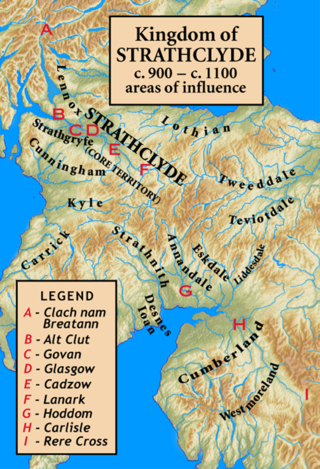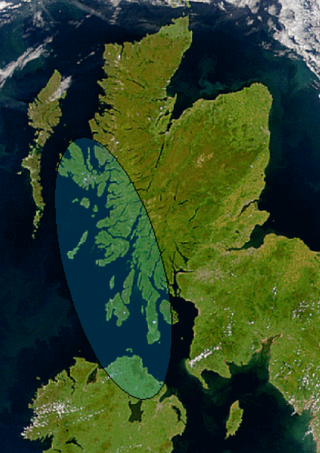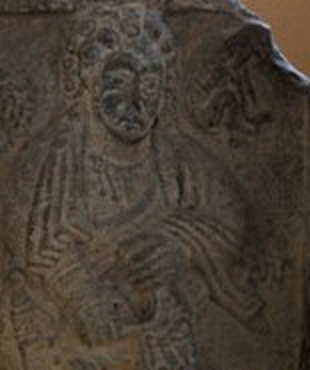Related Research Articles

Strathclyde was a Brittonic kingdom in northern Britain during the Middle Ages. It comprised parts of what is now southern Scotland and North West England, a region the Welsh tribes referred to as Yr Hen Ogledd. At its greatest extent in the 10th century, it stretched from Loch Lomond to the River Eamont at Penrith. Strathclyde seems to have been annexed by the Goidelic-speaking Kingdom of Alba in the 11th century, becoming part of the emerging Kingdom of Scotland.
Muiredach mac Ainbcellaig was king of the Cenél Loairn and of Dál Riata from about 733 until 736.
Ferchar Fota was probably king of the Cenél Loairn of Dál Riata, and perhaps of all Dál Riata. His father is named as Feredach mac Fergusa and he was said to be a descendant in the 6th generation of Loarn mac Eirc.

Áedán mac Gabráin, also written as Aedan, was a king of Dál Riata from c. 574 until c. 609 AD. The kingdom of Dál Riata was situated in modern Argyll and Bute, Scotland, and parts of County Antrim, Ireland. Genealogies record that Áedán was a son of Gabrán mac Domangairt.

Óengus son of Fergus was king of the Picts from 732 until his death in 761. His reign can be reconstructed in some detail from a variety of sources. The unprecedented territorial gains he made from coast to coast, and the legacy he left, mean Óengus can be considered the first king of what would become Scotland.

Bridei son of Beli ; died 692) was king of Fortriu and of the Picts from 671 until 692. His reign marks the start of the period known to historians as the Verturian hegemony, a turning point in the history of Scotland, when the uniting of Pictish provinces under the over-kingship of the kings of Fortriu saw the development of a strong Pictish state and identity encompassing most of the peoples north of the Forth.
Bridei son of Der-Ilei was king of the Picts from 697 until 706. He became king when Taran was deposed in 697.
Nechtan grandson of Uerb, was king of the Picts from 595 to around 616, and may be the same person as the Neithon son of Guipno who ruled the kingdom of Alt Clut.
Gartnait, son of Domelch, was a king of the Picts from 584 to 595.
Neithon son of Guipno was a 7th-century ruler of Alt Clut, a Brittonic kingdom based on Dumbarton Rock. According to the Harleian genealogies, he was the son of Guipno map Dumnagual Hen. Alfred Smyth suggests he is the same man as King Nechtan the Great of the Picts, and perhaps the Nechtan son of Canu the Annals of Ulster record as having died in 621. The Senchus fer n-Alban indicate that Gartnait, the son of Áedán mac Gabráin, King of Dál Riata, sired a son named Cano, but unless the Harleian genealogies are to be ignored, this would make Gartnait and Dumnagual Hen the same persons, as the respective fathers of Gartnait and Guipno. However, it is possible that either as an Alt Clut Briton ascending the throne of Pictland, or as a Pict ascending the throne of Alt Clut, his genealogy might have been altered, and it is notable that in the Pictish king-lists he is called "Nechtan, nepos Uerb", suggesting that it was a descent from Uerb that mattered in Pictland, and not his unimportant father Guipno/Canu. Alan Orr Anderson pointed out that Uerb is probably the Pictish form of Ferb, a female name. Alan MacQuarrie suggests that Neithon was indeed the Pictish king Nechtan, but does not take any stance on the Guipno/Canu problem.
Eugein or Ywain was a ruler of Alt Clut, a Brittonic kingdom based on Dumbarton Rock, sometime in the mid-7th century. According to the Harleian genealogies, he was the son of Beli I, presumably his predecessor as king, and the father of Elfin, who ruled sometime later. The Annals of Ulster and the Annals of Tigernach record another probable son, Dumnagual, who ruled Alt Clut and died in 694. Eugein was probably the brother or half brother of Bridei III of the Picts, the victor at the Battle of Dun Nechtain.
Guret was a ruler of Alt Clut, a Brittonic kingdom based on Dumbarton Rock, during the mid-7th century. He is known only from an obituary note in the Annals of Ulster, which records Mors Gureit regis Alo Cluathe under the year 658. He is absent from the Harleian genealogies, which record the names of many other kings of Alt Clut. Historian Alan MacQuarrie suggests that he may have been an otherwise unrecorded brother, or perhaps son, of Eugein I of Alt Clut.
Beli II was a king of Alt Clut, a Brittonic kingdom based on Dumbarton Rock, for some period in the early 8th century.
Teudebur of Alt Clut was the ruler of Alt Clut, in the early-to-mid eighth century. According to the Harleian genealogies, he was the son of Beli II, his probable predecessor as king. Such information is confirmed by both the Irish and Welsh annals. We know from the Harleian genealogy that he was the father of Dumnagual III, one of his successors. His reign coincided with that of the illustrious Pictish king Óengus mac Fergusa. The Annales Cambriae reports that in 750, the Britons defeated a Pictish army at Mocetauc (Mygedawc), in which, according to the Annals of Tigernach, Óengus' brother Talorgen was killed. Mygedawc is often identified with modern Mugdock, on the boundary between Dunbartonshire and Stirlingshire, but this identity is by no means certain. The Annals of Tigernach, which styles him Taudar mac Bile, rí Alo Cluaide, put his death at 752, and for this reason, we can be certain Teudebur was the British king responsible for the British victory.
Eugein II may have been ruler of Alt Clut, the Brittonic kingdom later known as Strathclyde, for some time in the late-8th century. He is known only from the Harleian genealogies, which indicate that he was the son of King Dumnagual III of Alt Clut; there is no direct evidence that he ruled as king himself. Dumnagual is presumed to be the monarch who submitted to the joint army of Kings Óengus I of the Picts and Eadberht of Northumbria in 756; after this event, Alt Clut seems to have remained under foreign power and the royal line is known exclusively through the Harleian genealogies for more than a century. If Eugein was king, he may have been in power during the "burning of Ail Cluaithe" recorded in the Annals of Ulster as having occurred in 780. According to Harleian, he was the father of Riderch II.
Talorg son of Uuid was a king of the Picts from 641 to 653.
Alpín was king of the Picts from 726-728, together with Drest. The Pictish Chronicle king lists give Alpín and Drest a five-year joint rule.
Finguine Fota or Finguine son of Eochaid was king of Cowal in modern-day Scotland, and a member of the Gaelic Cenél Comgaill kindred.
Gwid son of Peithan was a warband leader allied with the northern Britons fighting against the Angles of Northumbria in the early 7th century, recorded in the Welsh poem Y Gododdin. He is described in Y Gododdin as a "steadfast warrior" and may have been either a southern Pict or a northern British chief.
References
- Charles-Edwards, T. M. (2006). The Chronicle of Ireland. Translated Texts for Historians. Vol. 44. Liverpool: Liverpool University Press. ISBN 0-85323-959-2.
- Fraser, James E. (2009). From Caledonia to Pictland: Scotland to 795. New Edinburgh History of Scotland. Vol. I. Edinburgh University Press. ISBN 978-0-7486-1232-1.
- Hughes, Kathleen (1972). Early Christian Ireland: Introduction to the Sources . Cornell University Press. ISBN 0-8014-0721-4.
- MacQuarrie, Alan (1993). A. Grant; K. Stringer (eds.). "The Kings of Strathclyde". Medieval Scotland: Crown, Lordship and Community. Edinburgh University Press: 1–19.
- Smyth, Alfred P. (1989), Warlords and Holy Men: Scotland AD 80–1000, Edinburgh: Edinburgh University Press, ISBN 0-7486-0100-7